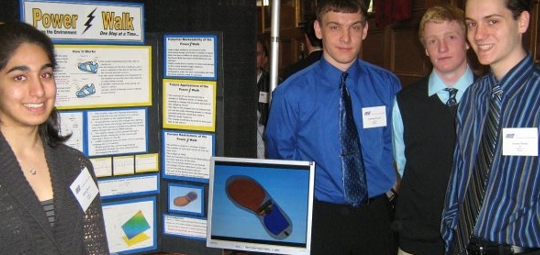Team Power Walk powers its way to first place
Malini Jhaver, Raphael Kopala, Christopher Lammers, Daniel Belisle.
Team Power Walk sat down together to answer some questions about their winning design:
What is your project about?
Essentially, we redesigned the sole of a shoe to contain an electric generator. The mechanism consists of two air pouches located inside the shoe, one under the ball of the foot, and one under the heel. As the user walks, the pressure created from the air pouches is channeled through a tube pushing a magnet back and fourth. The tube containing the magnet is wrapped with a wire coil, and the moving magnet creates an induced alternating current. This current passes through various electronic components to convert it to direct current, which we then use to charge a double A battery. The double A battery can either be removed from the sole to power personal electronics, or the user may plug into a port located at the back of the shoe. Thus, we allow the owner of the shoe access to a source of electricity when he or she is on the run.
Why did you decide that this is what you wanted to focus on?
Most environmentalists agree that minor changes to daily routines can have a large global effect. With this in mind, we considered the possible overall benefits a device such as the Power Walk may have.
Originally, we considered a wide range of ways to reduce an individual’s environmental impact. This included scrubbing air pollution, waste water heat recovery, home vegetable gardens etc. After careful deliberation and many more good ideas, we decided that we wanted a product that both benefitted the environment and had an economic appeal. This led us to wearable electric generators.
Personal electric generators have the convenience of being able to provide power when the user needs it. For example, consider a cell phone unexpectedly running out of battery. The customer would enjoy the luxury of having two charged double A batteries (one per shoe) at their disposal, especially if they needed to make a phone call. After all, a customer in need is a customer indeed.
After considering many ways of harnessing various sources of energy, including kinetic energy and solar energy, we decided that an unnoticeable and fully concealed electric shoe generator would be the best approach. Thus, the Power Walk was born.
Any future plans for your design?
Currently, our plans for the future of Power Walk are limited.
However, we were approached by a fellow student who informed us that shoe companies are considering such a concept. Also, considering that most of us occasionally face a dead cell phone when it is most needed, having a backup source of electricity seems very convenient. We do consider the possibility of this someday being brought to market.
How exciting is it to be one of the top placing teams in ES 050?
We are ecstatic to have tied for first place. Honestly, we were a little surprised. We never really approached this as a competition, though we still worked hard to do our best. After visiting the displays of our fellow students, we knew that a great deal of groups produced high quality projects. We saw very unique approaches to help the environment, and it was evident that, to say the least, competition was thick. We considered that not all people would think a shoe is very exciting, and wondered if it would have any appeal. In all honesty, when we left the Design Showcase, we said to ourselves that there is a good chance that we would not win, but we were satisfied with having completed a successful project.
Also from this web page:
Contact
.: Becky Blue
Spencer Engineering Building, Room 2074
Telephone: (519) 850-2917 Fax: (519) 661-3808
contactwe@eng.uwo.ca



